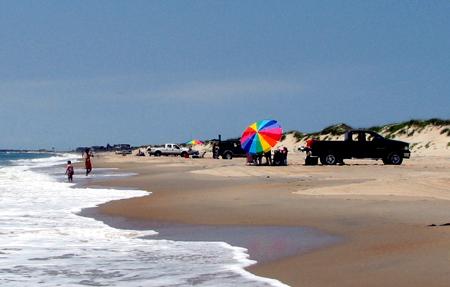Interior Department officials have been notified that a lawsuit will be forthcoming over decisions to designate critical habitat for piping plover at Cape Hatteras National Seashore.
[url=http://ncbba.powweb.com/buggyboard//viewtopic.php?p=493#493]
The notification[/url] was sent to Interior Secretary Dirk Kempthorne and U.S. Fish and Wildlife Service Director Dale Hall on Tuesday. Filed by the Washington, D.C., law firm of Holland and Knight, the notice was lodged on behalf of the North Carolina counties of Dare and Hyde, as well as the Cape Hatteras Access Preservation Alliance, a non-profit that represents, among others, the interests of surf anglers and beach buggy enthusiasts.
If you've been paying attention in recent months, you'll recognize that this fight revolves around decisions to close portions of Cape Hatteras National Seashore to vehicle and pedestrian access to protect species protected under the provisions of the Endangered Species Act.
In the notice, the groups claim U.S. Fish and Wildlife Service officials violated the ESA, as well as the National Environmental Policy Act and the Administrative Procedures Act, in their decisions to declare critical winter habitat for the plovers on both the national seashore and nearby Pea Island National Wildlife Refuge.
The agency's actions, says the notice, "have caused, presently are causing, and will foreseeably continue to cause, substantial harm and adverse impacts to CHAPA's members, the counties, and the thousands of people who rely on the Cape Hatteras National Seashore for their livelihood and recreation."
In addition to claiming FWS officials violated "mandatory, non-discretionary duties under the ESA," the groups say the designation of the critical habitat is unnecessary "in light of ongoing management under the seashore's Interim Plan."
The bottom line, maintain the groups, is that the critical habitat designation should be lifted and that the seashore and wildlife refuge be recognized as exempt from such designations.
Summary of Claims
• The FWS should have excluded the seashore and Pea Island National Wildlife Refuge from critical habitat designation because the benefits of exclusion outweighed the benefits of designation.
• The FWS should have excluded the seashore and Pea Island National Wildlife Refuge from critical habitat designation because the Interim Plan meets the FWS's exclusion requirements.
• The environmental assessment makes clear that the costs of designating critical habitat at the seashore and Pea Island outweigh the benefits.
• The economic analysis is still deficient. It arbitrarily relies on the discredited Vogelsong study and fails to adequately discuss "the effects of the designation on everyone who might be affected" as directed by Judge Lamberth.
• The FWS fails to satisfy Judge Lamberth's direction that FWS must adequately address how each identified primary constituent element would need management or protection
• The FWS has still failed to comply with NEPA. The FWS's Environmental Assessment contains virtually no science and does not address the extensive scientific data and analysis that CHAPA and the Counties submitted through their environmental consultant.
• The FWS has been arbitrary and capricious under the Administrative Procedures Act. The FWS record fails to make a "rational connection between the facts found and the choice made."




Comments
Anon, I'm afraid that trying to define environmental resource values in terms of human activities will not get you very far. Among the most valuable resources on the planet are ecosystems and landscapes providing free services in the form of watershed protection, erosion control, storm buffering, pollution filtering, aquifer recharge, nurseries for commercial fish stocks, etc. To qualify as resources, none of these areas/places require direct human access or exploitation. In fact, they would be resources even if no human ever set foot on them.
Recreational Area a Red Herring
All National Seashores have a recreational component to them despite if “Recreational Area” was added to the name of the park as an amendment to the enabling legislation to allow waterfowl hunting in that park, as was the case with Cape Hatteras National Seashore.
Recreation has a broad meaning to visitors. It can encompass a broad range of activities. Often, as the case with CHNS, the enabling legislation suggests the type of recreation intended with respect to other values associated with the Park.
(Except for certain portions of the area, deemed to be especially adaptable for recreational uses, particularly swimming, boating, sailing, fishing, and other recreational activities of similar nature, which shall be developed for such uses as needed, the said area shall be permanently reserved as a primitive wilderness and no development of the project or plan for the convenience of visitors shall be undertaken which would be incompatible with the preservation of the unique flora and fauna or the physiographic conditions now prevailing in this area . . .)
In addition with respect to the Organic Act and Park Policy recreation has a much broader meaning than ORV access.
No where in CHNS’s enabling legislation does it discuss what means of access to the Seashore was guaranteed. Presenting an outdated brochure that has “Recreational Area” in its title is not a mandate for ORV use anywhere in CHNS.
Anyone not familiar with CHNS would find it informative to take a close look at an aerial view from google earth at this park and see just how easy it is to access much of the beach without an ORV. Walking and boating are viable historical means of access that cause less recreational conflict and impairment of the Seashore resources and values than ORV use in some visitor’s opinion. Obviously ORV access and use is not impairment or conflict to those visitors using ORVs as their chosen means of access but to other visitors not accessing the Seashore’s beaches via a vehicle I can assure you ORV’s create a significant recreational conflict for them.